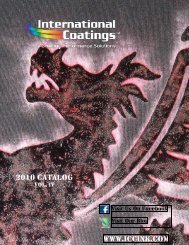2008 CATALOG WWW.ICCINK.COM
2008 CATALOG WWW.ICCINK.COM
2008 CATALOG WWW.ICCINK.COM
Create successful ePaper yourself
Turn your PDF publications into a flip-book with our unique Google optimized e-Paper software.
At what temperature do your inks cure?<br />
TEMPERATURE, CURE, FLASH<br />
The short answer is when the entire ink film thickness reaches its specified cure/fusion temperature. That temperature is<br />
provided on your specific ink’s product bulletin. Keep in mind that thicker ink deposits (e.g., High Density) take more time<br />
to reach their specified cure/fusion temperatures. Faster fusing or low cure inks will reach their fusion or cure<br />
temperatures more quickly than conventional inks.<br />
How long does it take for your inks to cure?<br />
There is not single easy answer. Many factors play into how long it takes to completely cure an ink. Are you using an<br />
electric dryer or a gas dryer? Does the print have a thick ink deposit? Are you printing on T-shirts or fleece? Measuring<br />
the ink temperature on the garment, as it passes through the dryer, is the best way to determine the time it takes for your<br />
inks to cure properly. Remember that it is important that the entire ink film thickness reach the specified cure/fusion<br />
temperature.<br />
How do I test to make sure my inks are cured?<br />
A wash test is the best method. Take a sample print, cut it in half, and wash it 3 to 5 times in a conventional washing<br />
machine with 3 pairs of jeans or towels. Set the washer for ‘Hot Wash/Cold Rinse’. Set the Dryer for ‘Cotton/High’ and<br />
dry for 30 minutes. Complete 3 to 5 wash cycles and compare the “washed” sample to the “unwashed” sample. If you<br />
see cracking of the ink film or ink loss, your inks are likely under-cured.<br />
What temperature and what length of time are needed for your inks to flash cure?<br />
Most ink will gel (flash) when the ink film reaches 220°F to 230°F (104°C to 110°C). There are 3 factors that affect the gel<br />
or flash of the ink: the temperature of the flash, the distance of the flash from the printed image, and the time the printed<br />
image is exposed to the heat. As a rule, you want to flash the ink film until t is just dry to the touch. Over-flashing inks can<br />
cause inter-coat adhesion problems and make the inks very “tacky”. Check your flash cure unit to see if it has<br />
temperature and airflow controls. These can help you better control your flash cure process.<br />
What happens if I don’t cure the ink properly?<br />
Many things, none of them good! Typical problems that arise from improperly cured inks include: ink washing off the<br />
garments, cracking of the ink film, loss of color, and bleeding of the garment color(s) into the ink film.<br />
Why do I need to flash?<br />
There are several reasons. Flashing enables you to print one coat of ink on top of another – e.g., a color on a white base.<br />
You also might flash an ink to keep wet ink off the back of your screens. Some inks, such as glitters, metallics and high<br />
densities, are not designed to be printed “wet-on wet”. They should be “flashed” when printing in sequence.<br />
Can I cure my inks with a flash cure unit?<br />
We do not recommend it! Although it is true you might be able to get the ink hot enough, a flash cure unit is not a good<br />
substitute for a properly operating dryer. Using just a flash cure, you could easily overheat the film surface yet under-cure<br />
the rest of your ink film, at the same time! Not a good idea – don’t do it!<br />
How do I know if my inks are cured properly?<br />
Your printed garments pass the wash test! (See above – “How do I test to make sure my inks are cured”)<br />
How do I measure ink temperature?<br />
There are 3 basic and easy-to-use temperature measurement devices you can use. First, a “heat tape” can be applied to<br />
the garment before it passes through the dryer. The tape will indicate the peak temperature of the garment within the<br />
dryer. Second, an infrared “Ray-Gun” can be used to measure the surface temperature of a printed garment as it exits<br />
the dryer. All you have to do is point the gun at the garment as it comes out of the dryer. And third, a “Thermo-Probe”<br />
can be placed in the “wet” ink film or on the garment to measure real-time temperatures as it passes through the dryer.<br />
Recording those temperatures at say, five second intervals, will give you a good profile on how well your dryer is working.<br />
You may be surprised with the results.<br />
126




